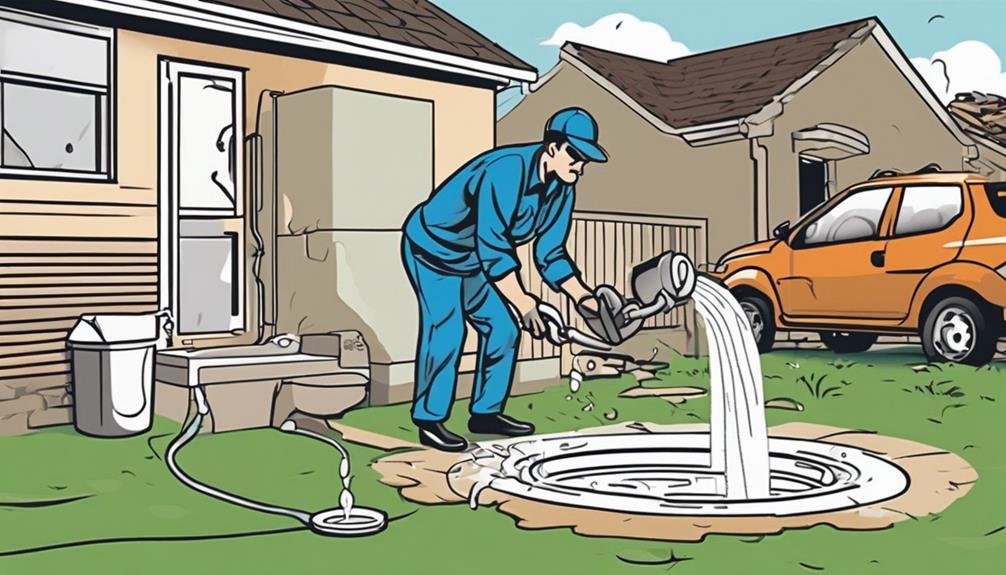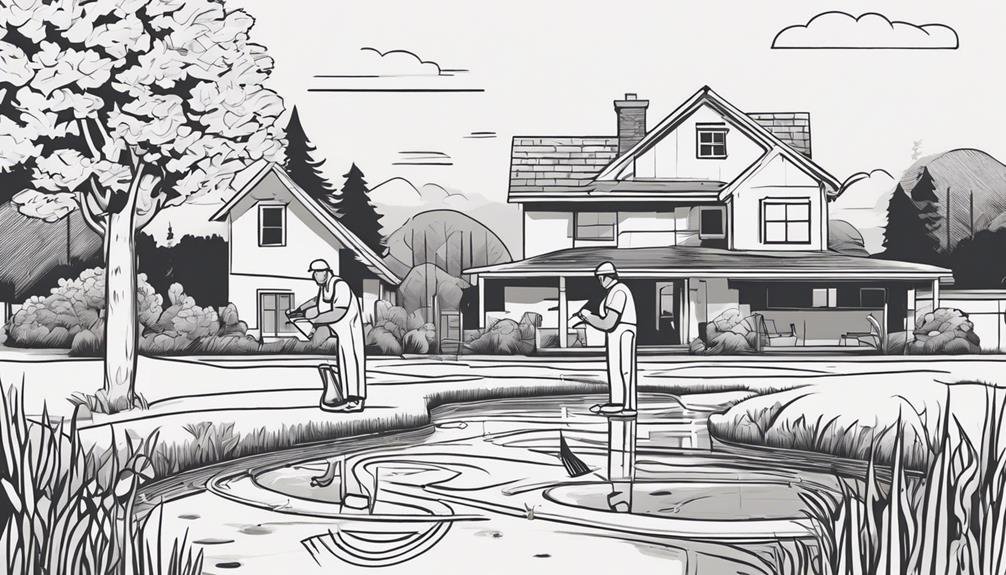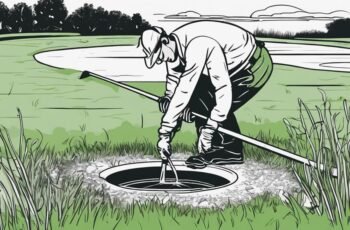Picture this: a serene backyard with lush greenery, a gentle breeze, and the sound of birds chirping.
Now, imagine the unpleasant scenario of a septic tank issue disrupting this tranquility.
To avoid such a disruption, there are practical DIY maintenance tips that can help ensure your septic system functions smoothly.
By incorporating these strategies into your routine, you can safeguard your home and the environment.
Key Takeaways
- Regular pumping every 3-5 years prevents blockages and backups.
- Use septic tank additives for efficient waste breakdown.
- Implement routine inspections for early issue identification.
- Maintain proper soil conditions for optimal drain field function.
Importance of Regular Pumping

Regularly pumping your septic tank is crucial to prevent costly and messy backups. The frequency of septic tank pumping depends on various factors such as the size of your tank, the number of people in your household, and your water usage. As a general guideline, it's recommended to have your septic tank pumped every 3 to 5 years.
However, if you have a larger household or notice any signs of a potential issue such as slow drains, gurgling pipes, or sewage odors, you may need to pump it more frequently.
Neglecting septic tank pumping can lead to a buildup of solid waste and sludge, causing blockages and backups that can result in expensive repairs and damage to your property. By staying on top of your septic tank maintenance and pumping schedule, you can avoid these issues and ensure that your septic system operates smoothly. Remember, prevention is key when it comes to septic tank care.
Water Conservation Practices
To maintain a well-functioning septic system and prevent unnecessary strain on your tank, implementing water conservation practices is essential. Conserving water not only helps your septic system but also benefits the environment and reduces your water bills.
Two effective water conservation methods for septic tank owners are rainwater harvesting and greywater reuse.
Rainwater harvesting involves collecting rainwater from your roof and diverting it into a storage tank. This harvested rainwater can then be used for activities such as watering your garden, washing your car, or flushing toilets. By using rainwater for these purposes, you lessen the amount of water entering your septic system, reducing the risk of overload.
Greywater reuse is another practical method where wastewater from sources like showers, sinks, and laundry can be treated and reused for non-potable purposes. This reduces the volume of water that enters your septic tank, extending its lifespan and decreasing the likelihood of issues.
Proper Disposal of Household Chemicals

Properly disposing of household chemicals is crucial for maintaining the health and functionality of your septic system. Improper disposal can lead to contamination of groundwater, harming the environment and posing serious health risks to your family.
To ensure household safety and protect your septic system, consider the following:
- Avoid Flushing Chemicals: Refrain from pouring chemicals like paint, solvents, pesticides, or bleach down the drain or toilet. These substances can disrupt the natural balance in your septic tank.
- Choose Eco-Friendly Alternatives: Opt for environmentally friendly cleaning products that are free from harsh chemicals. This not only benefits your septic system but also reduces your carbon footprint.
- Dispose of Hazardous Chemicals Properly: When getting rid of hazardous chemicals such as batteries, motor oil, or expired medications, find local collection facilities or events to safely dispose of them. This practice promotes both household safety and environmental well-being.
Implementing a Routine Inspection Schedule
Establish a consistent schedule for inspecting your septic tank to ensure its optimal performance and longevity. Regular inspections are crucial in identifying any potential issues early on, preventing costly repairs or replacements. Create an inspection checklist that includes tasks such as checking for any signs of leaks, ensuring the tank is watertight, and examining the levels of scum and sludge. By following this checklist during your inspections, you can stay on top of your septic tank's maintenance needs effectively.
In addition to regular inspections, consider using septic tank additives to promote the growth of beneficial bacteria and break down solid waste more efficiently. These additives can help maintain a healthy balance of bacteria in your tank, enhancing its overall function. However, be cautious and research the specific additives recommended for your system to avoid any potential harm.
DIY Drain Field Maintenance

Ensure your drain field remains in optimal condition by following these DIY maintenance tips.
- Regular Soil Aeration: Keep your drain field soil healthy and efficient by aerating it regularly. This process helps in maintaining proper oxygen levels in the soil, promoting the growth of beneficial bacteria that break down waste effectively.
- Monitor for Root Intrusion: Inspect your drain field area for any signs of root intrusion from nearby trees or plants. Roots can cause blockages and damage to the drain field pipes, leading to costly repairs. Consider planting trees at a safe distance to prevent future issues.
- Avoid Heavy Machinery: Refrain from driving or placing heavy machinery over the drain field area. Excessive weight can compact the soil, reducing its ability to absorb wastewater effectively. Opt for hand tools or lighter equipment when working near the drain field.
Taking these simple steps can help maintain the functionality and longevity of your drain field, ensuring your septic system operates smoothly.
Frequently Asked Questions
How Can I Tell if My Septic Tank Needs to Be Pumped Before the Recommended Timeframe?
If you notice foul septic tank odors or slow drains, it's time for an inspection. Early warning signs like sewage backups signal maintenance needs. Don't wait for the recommended timeframe; act promptly to avoid issues.
Are There Any Alternatives to Using Harsh Chemicals for Cleaning That Won't Harm My Septic System?
You might worry about the effectiveness of natural alternatives, but fear not! Eco-friendly solutions like vinegar, baking soda, or enzyme-based cleaners are gentle on your septic system while still keeping it clean and healthy.
What Are Some Signs of a Failing Drain Field That I Should Watch Out for During Routine Inspections?
When checking your septic system, be alert for soggy spots or odors in the yard, slow drains, or gurgling noises. These can signal drain field repair needs. Regular septic system inspection helps catch issues early, preventing costly repairs.
Can I Use a Septic Tank Additive to Help Maintain My System, and if So, Which Ones Are Safe and Effective?
You don't need septic tank additives to maintain your system effectively. Proper maintenance like regular pumping, water conservation, and avoiding flushing harmful items will keep your septic tank healthy. Save your money and stick to good practices.
How Can I Prevent Tree Roots From Invading My Septic System and Causing Damage?
To prevent tree roots from damaging your septic system, consider installing root barriers around the tank and drain field. Regular professional inspections and maintenance can also help catch any issues early on before they become costly problems.
Conclusion
To ensure your septic tank continues to function properly, remember these DIY maintenance tips.
By regularly pumping your tank, conserving water, disposing of chemicals properly, and inspecting your system, you can prevent costly issues down the line.
For example, imagine coming home to a foul odor in your yard because of a neglected septic tank.
By following these simple steps, you can avoid this scenario and keep your septic system running smoothly for years to come.

